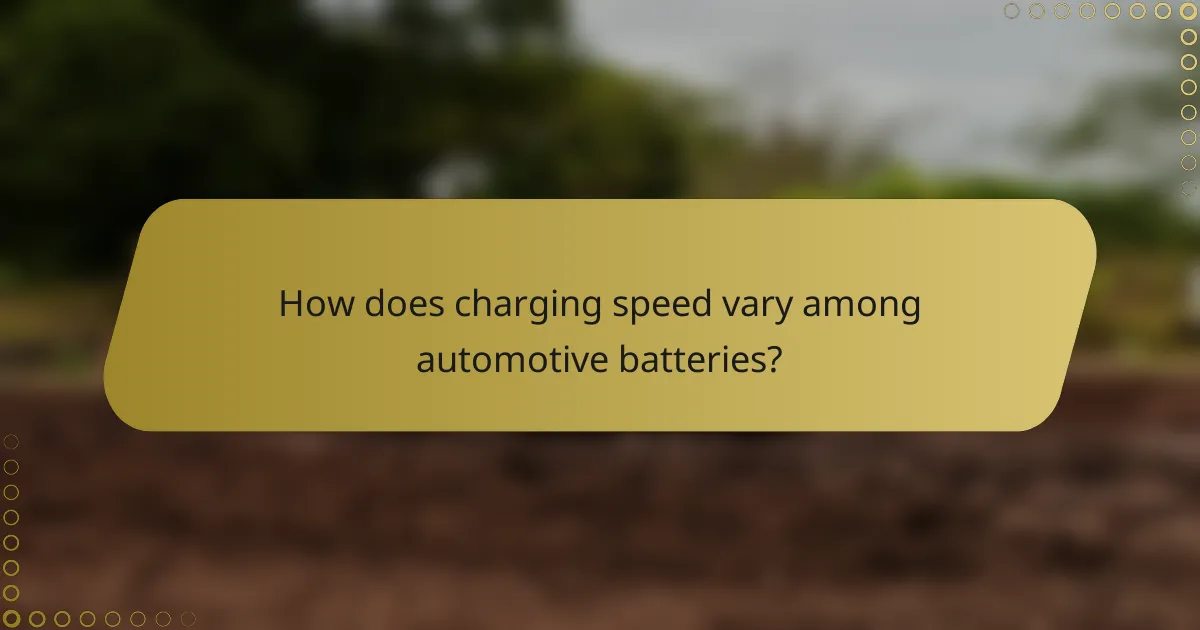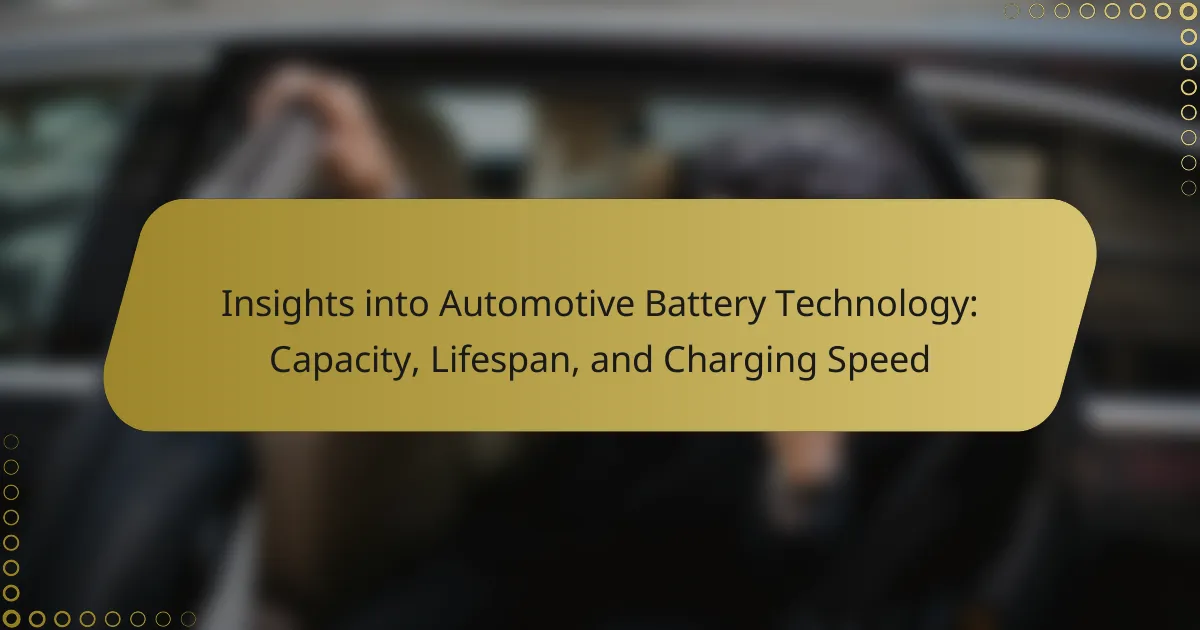Automotive battery technology encompasses the systems and components responsible for storing and supplying electrical energy in vehicles, including lead-acid, lithium-ion, and nickel-metal hydride batteries. Each battery type exhibits unique characteristics that impact vehicle performance, lifespan, and charging speed. Lithium-ion batteries are recognized for their high energy density and rapid charging capabilities, while lead-acid batteries are commonly utilized in traditional vehicles. Key factors affecting battery capacity include temperature, state of charge, discharge rate, and battery age, all of which influence overall efficiency. Understanding these aspects is crucial for advancements in electric and hybrid vehicles, particularly as lithium-ion technology becomes increasingly favored for its superior performance.

What is Automotive Battery Technology?
Automotive battery technology refers to the systems and components that store and supply electrical energy for vehicles. This technology primarily includes lead-acid, lithium-ion, and nickel-metal hydride batteries. Each type has distinct characteristics influencing performance and applications. For instance, lithium-ion batteries offer higher energy density and faster charging capabilities. Lead-acid batteries are commonly used in traditional vehicles for starting and powering electrical systems. The efficiency and lifespan of automotive batteries are critical for vehicle performance. Research indicates that lithium-ion batteries can last up to 15 years with proper maintenance. Understanding these technologies is essential for advancements in electric and hybrid vehicles.
How does Automotive Battery Technology function?
Automotive battery technology functions by storing and providing electrical energy for vehicle operation. These batteries typically use lithium-ion chemistry due to its high energy density and efficiency. When the vehicle is in use, chemical reactions within the battery generate electrical current. This current powers the electric motor and other electrical systems in the vehicle.
During charging, an external power source applies voltage to reverse the chemical reactions, restoring the battery’s charge. Automotive batteries are designed to withstand numerous charge and discharge cycles, often lasting several years. For example, lithium-ion batteries can typically endure 500 to 1,500 cycles before significant capacity loss occurs.
The efficiency of automotive batteries is crucial for vehicle performance and range. Advanced battery management systems monitor temperature, voltage, and current to optimize performance and safety. This technology ensures that the battery operates within safe limits, enhancing longevity and reliability.
What are the key components of an automotive battery?
The key components of an automotive battery include the positive plate, negative plate, electrolyte, separator, and terminal posts. The positive plate is typically made of lead dioxide. The negative plate consists of sponge lead. The electrolyte is a mixture of sulfuric acid and water. The separator prevents the plates from touching and short-circuiting. Terminal posts allow for electrical connections to the vehicle. These components work together to store and release electrical energy for vehicle operation.
How do these components influence battery performance?
Battery performance is influenced by components such as the anode, cathode, electrolyte, and separator. Each component plays a critical role in energy storage and transfer. The anode typically stores lithium ions during charging, affecting capacity. The cathode determines the voltage and energy density of the battery. The electrolyte facilitates ion movement, impacting charge and discharge rates. The separator prevents short circuits, ensuring safety and longevity. Research indicates that optimizing these components can enhance battery efficiency and lifespan. For example, advancements in cathode materials have led to batteries with higher energy densities, improving overall performance.
What are the main types of automotive batteries?
The main types of automotive batteries are lead-acid, lithium-ion, and nickel-metal hydride. Lead-acid batteries are the most common type. They are often used in traditional gasoline vehicles. Lithium-ion batteries are increasingly used in electric vehicles due to their higher energy density. Nickel-metal hydride batteries are primarily found in hybrid vehicles. Each battery type has unique characteristics suited for different vehicle applications.
What are the differences between lead-acid and lithium-ion batteries?
Lead-acid and lithium-ion batteries differ significantly in composition, performance, and application. Lead-acid batteries are heavier and bulkier, while lithium-ion batteries are lighter and more compact. Lead-acid batteries typically have a lower energy density, around 30-50 Wh/kg, compared to lithium-ion batteries, which can reach 150-250 Wh/kg.
In terms of lifespan, lead-acid batteries generally last 3-5 years, whereas lithium-ion batteries can last 8-15 years. The charging speed also varies; lead-acid batteries take longer to charge and often require specific charging protocols. In contrast, lithium-ion batteries can charge rapidly, often reaching 80% capacity in under an hour.
Lead-acid batteries are commonly used in automotive starter applications due to their cost-effectiveness. Lithium-ion batteries are favored in electric vehicles and portable electronics for their high efficiency and lighter weight. These differences highlight the suitability of each battery type for specific applications in automotive technology.
How do different battery types impact vehicle performance?
Different battery types significantly impact vehicle performance. Lithium-ion batteries offer high energy density, leading to longer driving ranges. They also have faster charging times compared to lead-acid batteries. Lead-acid batteries, while cheaper, provide lower energy density and longer charging durations. This limits their effectiveness in electric vehicles. Nickel-metal hydride batteries are more durable than lead-acid but less efficient than lithium-ion. Research indicates that lithium-ion batteries can improve acceleration and overall vehicle efficiency. According to a study by the U.S. Department of Energy, vehicles using lithium-ion batteries can achieve ranges of over 300 miles on a single charge.

What factors affect battery capacity in automotive batteries?
Battery capacity in automotive batteries is affected by several key factors. These factors include temperature, state of charge, discharge rate, and battery age. High temperatures can accelerate chemical reactions, potentially increasing capacity temporarily but leading to degradation over time. Low temperatures can reduce capacity due to slower chemical reactions. The state of charge impacts capacity as batteries typically perform best when not fully charged or deeply discharged. Discharge rate also plays a role; higher rates can lead to reduced available capacity. Lastly, battery age affects capacity due to wear and tear from repeated charge cycles, with older batteries generally holding less capacity than new ones.
How is battery capacity measured?
Battery capacity is measured in ampere-hours (Ah) or milliampere-hours (mAh). This measurement indicates the total charge a battery can store and deliver over time. For example, a battery rated at 100 Ah can theoretically provide 100 amps for one hour. The capacity can also be expressed in watt-hours (Wh), which combines voltage and ampere-hours. For instance, a 12V battery with a capacity of 100 Ah has a total energy capacity of 1200 Wh. Manufacturers often test battery capacity under specific conditions to ensure consistency and accuracy. This testing usually involves discharging the battery at a constant rate until it reaches a predetermined cutoff voltage.
What units are used to express battery capacity?
Battery capacity is expressed in ampere-hours (Ah) or milliampere-hours (mAh). These units measure the amount of electric charge a battery can deliver over time. For example, a battery rated at 1000 mAh can supply 1000 milliamperes for one hour. Ampere-hours are commonly used for larger batteries, while milliampere-hours are used for smaller batteries. This distinction helps in understanding the duration a battery can power a device before needing a recharge.
How does capacity relate to vehicle range?
Capacity directly influences vehicle range. Higher battery capacity allows for more energy storage. This increased energy enables the vehicle to travel farther on a single charge. For electric vehicles, capacity is typically measured in kilowatt-hours (kWh). A vehicle with a 60 kWh battery can generally achieve a longer range than one with a 30 kWh battery. For instance, a Tesla Model 3 with a 75 kWh battery can travel approximately 353 miles. In contrast, a smaller vehicle with a 40 kWh battery may only achieve around 150 miles. Therefore, capacity is a critical factor in determining the overall driving distance of electric vehicles.
What influences the lifespan of automotive batteries?
The lifespan of automotive batteries is influenced by several factors. Temperature extremes can significantly affect battery performance. High temperatures can accelerate chemical reactions, leading to degradation. Conversely, low temperatures can reduce battery capacity and efficiency.
Charging practices also play a crucial role. Overcharging can cause overheating and damage, while deep discharging can shorten lifespan. Regular maintenance, such as checking fluid levels and terminal connections, is essential for longevity.
Battery type is another influencing factor. Lead-acid batteries typically have a shorter lifespan compared to lithium-ion batteries. Usage patterns, including driving habits and frequency of use, impact how long a battery lasts.
Environmental conditions, such as humidity and exposure to corrosive elements, can also contribute to battery wear. Ultimately, proper care and understanding of these factors can help extend the lifespan of automotive batteries.
What are the common factors that shorten battery lifespan?
Common factors that shorten battery lifespan include high temperatures, deep discharges, and frequent charging cycles. High temperatures can accelerate chemical reactions within the battery, leading to faster degradation. Deep discharges, where the battery is drained to very low levels, can damage the battery’s internal structure. Frequent charging cycles, especially rapid charging, can also contribute to wear and tear. Each of these factors has been shown to reduce the overall capacity and efficiency of batteries over time. Studies indicate that maintaining moderate temperatures and avoiding deep discharges can significantly extend battery life.
How can proper maintenance extend battery life?
Proper maintenance can significantly extend battery life. Regularly checking battery terminals for corrosion helps ensure good connections. Keeping the battery clean prevents buildup that can hinder performance. Maintaining the correct fluid levels in lead-acid batteries is crucial for optimal function. Avoiding deep discharges can prevent damage to the battery’s cells. Ensuring the battery is charged properly and not overcharged protects its lifespan. Temperature management is also important; extreme heat or cold can shorten battery life. Following these practices can enhance battery longevity and efficiency.

How does charging speed vary among automotive batteries?
Charging speed varies significantly among automotive batteries based on their chemistry and design. Lithium-ion batteries typically charge faster than lead-acid batteries. For instance, lithium-ion batteries can achieve up to 80% charge in 30 minutes under optimal conditions. In contrast, lead-acid batteries may take several hours to fully charge.
The charging speed also depends on the battery management system and charger specifications. Fast chargers can increase charging speed for compatible batteries, while standard chargers may limit it. Additionally, factors such as temperature and battery age can affect charging efficiency.
Overall, lithium-ion technology is favored for electric vehicles due to its superior charging speed and efficiency compared to traditional battery types.
What are the different charging methods for automotive batteries?
The different charging methods for automotive batteries include standard charging, fast charging, and trickle charging. Standard charging typically uses a lower current to fully charge the battery over several hours. Fast charging employs higher currents, significantly reducing charging time to under an hour in some cases. Trickle charging provides a low, continuous charge to maintain battery levels without overcharging. Each method has its applications based on battery type and usage needs. For instance, electric vehicles often utilize fast charging for convenience. Standard charging is common for traditional lead-acid batteries in vehicles. Trickle charging is beneficial for maintaining batteries in vehicles that are not frequently used.
How does fast charging impact battery health?
Fast charging can negatively impact battery health over time. The increased heat generated during fast charging can accelerate chemical reactions within the battery. This may lead to faster degradation of battery materials. Additionally, fast charging can cause lithium plating on the anode, reducing capacity. Research indicates that frequent fast charging can shorten overall battery lifespan. A study by NREL found that batteries charged at high rates showed significant capacity loss compared to those charged slowly. Therefore, while convenient, fast charging may compromise long-term battery performance.
What is the role of charging infrastructure in battery charging speed?
Charging infrastructure directly influences battery charging speed. The type of charging station affects the power output delivered to the battery. Level 1 chargers provide 120 volts and are the slowest option. Level 2 chargers offer 240 volts, significantly reducing charging time. DC fast chargers deliver high voltage, enabling rapid charging sessions. The compatibility of the vehicle with the charging infrastructure also plays a crucial role. Vehicles equipped for higher charging rates can utilize faster charging stations effectively. Additionally, the condition and maintenance of the charging equipment impact performance. Properly functioning infrastructure ensures optimal energy transfer to the battery.
What are the latest advancements in automotive battery technology?
The latest advancements in automotive battery technology include solid-state batteries, lithium-silicon anodes, and fast-charging capabilities. Solid-state batteries offer higher energy density and improved safety compared to traditional lithium-ion batteries. Lithium-silicon anodes can significantly increase battery capacity, potentially doubling the energy storage. Fast-charging technology has progressed, allowing electric vehicles to charge in under 30 minutes. Research indicates that these advancements can enhance the overall performance and lifespan of automotive batteries. For instance, solid-state batteries have been shown to last longer and operate more efficiently in various temperatures. These innovations are paving the way for more sustainable and efficient electric vehicles.
How are new materials improving battery efficiency?
New materials are enhancing battery efficiency by increasing energy density and reducing charge times. Advanced lithium-silicon anodes can store more lithium ions than traditional graphite. This leads to higher capacity and longer-lasting batteries. Solid-state electrolytes improve safety and performance by eliminating flammability risks associated with liquid electrolytes. Nanostructured materials enhance conductivity, allowing for faster electron transfer. Research indicates that these innovations can increase battery lifespan by up to 30%. Additionally, materials like graphene improve thermal management, preventing overheating. Overall, these advancements are crucial for the development of more efficient automotive batteries.
What innovations are being developed to enhance charging speed?
Innovations to enhance charging speed include solid-state batteries and ultra-fast charging technologies. Solid-state batteries use a solid electrolyte instead of a liquid one. This change allows for higher energy density and faster ion movement. Ultra-fast charging technologies employ advanced cooling systems and higher voltage levels. These systems reduce charging time significantly, often to under 15 minutes for a full charge. Research from the Department of Energy indicates that these innovations can improve charging efficiency by up to 80%. Additionally, companies are developing wireless charging systems that can charge vehicles while in motion. These advancements collectively aim to reduce the time required for electric vehicle charging.
What best practices should be followed for optimal battery performance?
To achieve optimal battery performance, follow these best practices. Regularly charge the battery to maintain its capacity. Avoid deep discharges, as they can reduce lifespan. Store the battery in a cool, dry place when not in use. Keep the battery terminals clean to ensure good connections. Use the manufacturer’s recommended charger for efficiency. Monitor the battery temperature during charging to prevent overheating. Limit exposure to extreme temperatures, as they can affect performance. These practices enhance battery longevity and efficiency, ensuring reliable operation in vehicles.
How can drivers maximize the lifespan of their automotive batteries?
Drivers can maximize the lifespan of their automotive batteries by maintaining proper charging habits. Regularly check the battery’s charge level to avoid deep discharges. Keeping the battery terminals clean prevents corrosion. Ensure the battery is securely mounted to avoid vibrations. Limit short trips to reduce the frequency of charging cycles. Monitor the vehicle’s electrical system for any parasitic drains. Extreme temperatures can negatively affect battery life, so park in shaded or climate-controlled areas when possible. Following these practices can extend battery life by several years, as studies indicate that proper maintenance can improve battery longevity by up to 30%.
What routine checks should be performed to ensure battery efficiency?
Routine checks to ensure battery efficiency include inspecting the battery terminals for corrosion. Corrosion can impede electrical flow and reduce performance. Next, check the battery’s voltage using a multimeter. A healthy battery typically shows a voltage above 12.4 volts. Additionally, examine the fluid levels in non-sealed batteries. Low fluid levels can lead to overheating and damage.
Inspect the battery for physical signs of wear or damage, such as cracks or bulges. These issues can affect battery function. Regularly clean the battery and its terminals to prevent buildup. Lastly, monitor the battery’s charging cycles and ensure it is charged correctly. Following these checks can enhance battery lifespan and efficiency.
Automotive battery technology encompasses the systems and components that store and supply electrical energy for vehicles, primarily including lead-acid, lithium-ion, and nickel-metal hydride batteries. This article provides insights into the functionality, key components, and performance differences among these battery types, emphasizing their impact on vehicle efficiency and lifespan. It also examines factors affecting battery capacity, lifespan, and charging speeds, alongside best practices for maintenance and the latest advancements in battery technology. Understanding these elements is crucial for the development and optimization of electric and hybrid vehicles.
